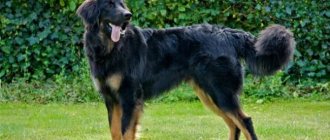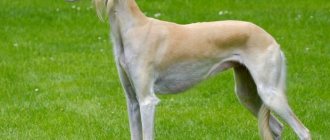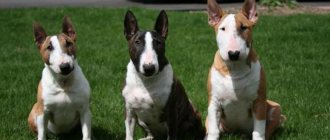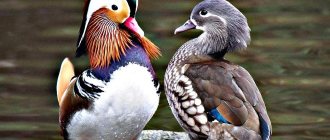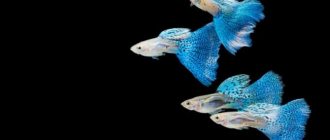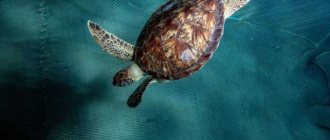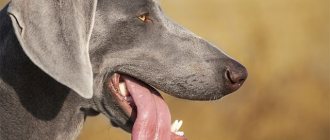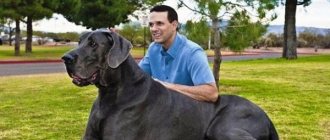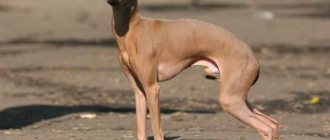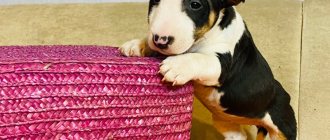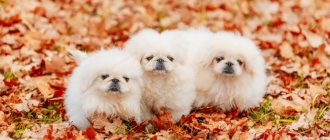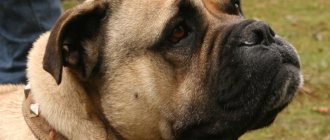Home » Dog Breeds
Classification Origin: Hungary
Class: according to accepted FCI standards, the breed is classified in group 1 (guard and driving dogs, with the exception of Swiss snow dogs)
Section 1: herding dogs. No operational tests
Application: as a pet, for protection and as a herding dog
Dimensions: Male height – 71-76 cm; female height – 66-70 cm; male weight – 48-62 kg; female weight – 37-50 kg
Lifespan: 10 to 12 years
The Kuvasz is a beautiful dog that has courage, strength and an extraordinary sense of freedom. She loves movement, becomes very attached to her owner and is ready to protect him at any time.
Kuvasz is a fairly ancient breed of dog that was used by shepherds along with Beaucerons , Kangals , Groenendaels and Hovawarts .
At its core, it is a rather unpretentious and hardy dog that copes well with guarding livestock.
Today it is not only a shepherd breed. Kuvasz is a wonderful companion and a great friend for any family member.
Punishment in the form of being locked in a cage or chain can lead to depression or aggression in a dog
- 2 Character and behavioral characteristics
- 3 Application
- 4 Kuvasz puppies: what to look for when choosing?
- 5 Features of care
- 6 Walking
- 7 Feeding
- 8 Health
- 9 Characteristic diseases of the breed
- 10 Vaccinations
- 11 Mating
History of the breed
For some time, there was quite a lot of controversy about the origin of this breed. Someone was inclined to believe that the dog appeared in the Carpathian Basin region along with Komondors (Hungarian shepherd dogs).
Indeed, since ancient times, the Hungarian Kuvasz together with the Komondors have been mentioned as two types of breeds that are reliable guards and faithful helpers in the pasture.
Important! In ancient times, shepherds tried to choose only those dogs whose color was completely snow-white. This was done for the reason that in the dark, gray-colored individuals could easily be confused with a predatory animal.
This breed became most popular during the reign of Matt Corvinus (15th century). The king loved these dogs so much that he was constantly surrounded by them.
At the same time, the highest sign of praise for any person from the monarch was a gift in the form of a Kuvasz puppy.
The Hungarian kuvasz was first exhibited in Hamburg at the end of the 19th century. Reliability and good security qualities were appreciated.
After this, the dog breed was increasingly found in the private homes of city residents.
However, after the end of the First World War, there was a very strong decline in this breed.
According to statistics, only about three dozen individuals remain in the homeland of the Kuvasz, Hungary. And only thanks to connoisseurs, this breed was gradually reborn from the ashes.
The article will tell you about other rare and endangered dog breeds
How to choose a puppy
There are still very few Kuvasz dogs in the post-Soviet space, and the first breeding nurseries began to appear only ten years ago. An exclusive puppy produced by them is quite expensive - on average, $1,200, and a promising baby will cost an even larger amount. It makes sense to buy a small kuvasz in Hungary - its cost, including delivery, will be lower, and the choice will be much greater.
Choosing the right Kuvasz puppy is not easy.
In the historical homeland of the Kuvasz, it is quite possible to find a puppy with show potential and interesting bloodlines for 600–700 dollars, and an excellent working dog for 300–400.
To avoid becoming a victim of scammers, such a purchase cannot be made privately - on the market or through an advertisement on the Internet. Only in a reputable breeding nursery and only under an agreement with the breeder - this will guarantee the breed of the puppy and its health. What you should pay attention to when choosing, so as not to get a cute white mongrel instead of an exclusive kuvasz:
- on the head - study the standard, the Kuvasz head parameters are unique (a wide skull with an elongated muzzle, a soft “stop”, slightly slanted eyes and slightly raised ears on the cartilage);
- in terms of body proportions - a small kuvasz looks like an “ugly duckling”; up to six months it has a disproportionately large head and thin legs;
- on the coat - even in puppyhood, the Kuvasz has a special coat, moderately hard and wavy, with abundant down;
- on pigment - as for a white dog, the Kuvasz has excessive pigmentation (black nose, dark spots on the palate and gums, gray skin).
Character and behavioral characteristics
This breed combines many good qualities:
- mind;
- calmness and balance;
- understanding;
- friendliness.
However, this dog requires constant attention. After all, behavior problems are often caused precisely by a lack of time for a pet or a lack of knowledge regarding training.
Important! If you want your Kuvasz to be kind and confident, you should not put him on a chain. This can cause the dog to become aggressive or even depressed.
Training requires a lot of time and patience. However, after it expires, you will be rewarded - you will always have a faithful and brave comrade with you, capable of standing up for you.
The result largely depends on how well you explained your desire to the dog. If she understands you, she will gladly carry out the command.
Kuvasz loves when her owner talks to her. The more often such contact occurs, the better she will understand commands.
The “herding” genes in the Hungarian Kuvasz are reflected in an incredible love of walking. However, at home he is a calm and friendly companion.
Kuvasz dogs are in heat
What should a bitch owner know?
- age of onset of the first estrus in a female is 6-12-14 months;
- duration of estrus is 20-22 days, sometimes up to a month;
- frequency of estrus – 1-2 times a year with an interval of 6-9 months;
- signs of estrus – swelling of the dog’s external genitalia, spotting;
- frequent urination - having to walk more often than usual;
- psychological signs - a change in the dog’s behavior - from aggressive to lethargic;
- perhaps there is a change in appetite and the dog drinks more water;
- often bitches begin to shed before going into heat;
- lick the loop intensively.
How to notice the onset of heat?
You can notice the approach of estrus while walking your dog. Behavior can change, often the dog becomes active, playful and disobedient, or, on the contrary, looks unhappy and lethargic. The bitch makes frequent marks - scent “lures” for male dogs, and urination occurs more frequently. The loop becomes more and more swollen; when pressed, you can see a discharge of light pink or dull pink color. If you notice changes in the dog's behavior, do not be lazy and check the dog every day for the onset of heat by dabbing the bitch's loop with a napkin or toilet paper. Pinkish discharge will be the beginning of estrus - mark this day in your dog’s notebook.
The course of the dog's first heat.
- The first heat in dogs is not the same as the next one.
- It may be shorter or longer than the usual estrus period.
- The bitch has either only weak manifestations of estrus, or, conversely, very heavy discharge.
- The first heat may suddenly stop, and then after some time begin again.
- There may be mucous discharge from the loop, a smell that attracts males, and the estrus itself will begin after some time.
- Try not to miss the start time of the first, and subsequently the second estrus, in order to correctly determine the intervals between estrus and know their timing and duration.
Precautions during estrus.
If you are not interested in getting puppies from a dog, you need to take precautions during heat:
- walk your dog only on a leash: even the most obedient dog these days can simply run away, not paying attention to commands;
- do not allow male dogs to mount the dog: if sexual intercourse begins, it is almost impossible to separate them;
- during a walk, literally do not take your eyes off the dog, even when buying bread in a tent, eliminate or minimize contact with male dogs;
- there is a danger of the dog catching a cold in the cold season, the best way to protect yourself is not to walk for a very long time in cold weather and use dog clothes;
- If your dog lives freely on your territory, then from the moment the estrus begins, lock the dog in an enclosure.
Application
If previously the Hungarian Kuvasz was a shepherd dog, now it is a pet, a wonderful companion, and a reliable guard.
Thanks to his character, which is not inferior to the Australian Shepherd , he gets along easily with children.
A photo of this breed evokes affection and instant sympathy. However, this cute pet bravely stands up for its owner and is unlikely to allow a stranger into its territory
Important! Since this breed is independent, it requires a skilled and experienced owner, as training can take quite a long time.
Kuvasz loves communication very much. Therefore, you can talk to him, and this will only strengthen the connection between the dog and the owner.
Owner reviews about kuvasz
I have been breeding Hungarian Kuvasz for 8 years. The breed of these dogs is still not very popular in our country , but interest in it is growing every year. Future owners need to know that the dog will be comfortable living in freedom, where there is a large fenced area , but in an apartment he will simply wither away
Olga Kuvas is a shepherd dog, as was originally intended. And now such dogs are in demand among those involved in agriculture. The dog perfectly herds a herd of 10-20 heads , and if the herd is larger, then more dogs are needed
Daniel
Kuvasz puppies: what to look for when choosing?
When you first see a photo of a small Kuvasz, the question of whether or not to purchase this cute canine representative disappears by itself.
Actually, how can you not want this cute snow-white bear cub as a pet?
When choosing puppies, it is best to pay attention to representatives several months old. Thus, the new family member gets used to new conditions and the owner from infancy.
Important! There is an opinion that the kuvasz chooses its owner. Often this becomes a male representative, since the Hungarian Kuvasz agrees to obey only a strong person with a strong character.
The behavior of this dog largely depends on how it is handled and kept. Therefore, the owner must be a responsible person who has enough time to train, raise and care for the dog.
When purchasing, it is best to contact reliable breeders and nurseries. This ensures that in addition to the puppy, you can examine the parents, obtain the necessary documents, and also enlist the support of specialists.
Training
The breed requires long and hard training, which should be entrusted to a specialist. Kuvasz has a self-sufficient, independent character and therefore will obey only a strong, authoritative owner. A dog needs affection and love from its owner. The baby begins to be socialized from the first days of his life in the house, accustoming him to his surroundings.
From four months they begin to go to the training ground, where the puppy learns to communicate with other animals and clearly sees the training process from their example and learns obedience. By the age of three, the Hungarian Kuvasz must be fully educated and trained. They recommend methodical education and training in a way of motivating and rewarding success, without raising your voice or using physical punishment.
Features of care
Proper maintenance and care of your Kuvasz is the key to ensuring that the dog will always obey and behave adequately.
Kuvasz has a fairly long coat, which is also white in color. Regular brushing is what this breed needs first and foremost.
The coat does not need to be trimmed or cut, but during shedding it is worth using a furminator .
The fur on the paws and face is shorter. In other places it is longer. The coat can be either straight or wavy.
Important! Grooming takes a lot of time. Especially in the autumn and spring periods, when dogs shed heavily.
Dogs that live in an enclosure shed twice a year. But for individuals who live in apartments, this process can practically never stop.
This white Hungarian miracle will be a wonderful companion
Description
Kuvasz is a very large breed, males reach 70 - 76 cm at the withers and weigh 45 - 52 kg. Bitches are smaller, 65-70 cm at the withers, weigh 32-41 kg. Although larger specimens are not uncommon, in general Kuvasz appear to be less clumsy than other large breeds and much more agile.
The Kuvasz's muzzle is closer to that of retrievers than to the guard dogs of the mastiff group. It is considered a decoration of the dog and is given special attention at the show. The muzzle is long, wide, with a black nose.
It is located on a wedge-shaped head. Some dogs may have long facial skin, but wrinkles should not form. The eyes are almond-shaped, dark brown, the darker the better. The ears are v-shaped, with slightly rounded tips.
The coat is double, the undercoat is soft, the outer coat is hard. In some dogs it is straight, in others it may be wavy.
The hair is shorter on the face, ears, paws and front of the paws. On the rest of the body it is of medium length, forms panties on the hind legs, is slightly longer on the tail, and has a noticeable mane on the chest and neck.
Actual coat length varies throughout the year as most dogs shed in the summer and grow their coat in the fall.
Kuvasz should only be one color - white. Coat markings or shades are not allowed. Some dogs may be ivory-colored, but this is not desirable. The color of the skin under the coat should be slightly gray or black. This is a working breed and should look the part. The body is muscular and slender, the tail is long and usually carried low. If the dog is excited, it raises it to body level.
Walk
If you have decided to get a dog, and your home is an apartment, you need to seriously think about whether the dog will be provided with the necessary level of activity.
After all, an ordinary apartment will hardly be a dog’s favorite place. In this case, the dog should be walked for at least two hours, active games such as agility .
A dog's development stops at about 1-1.5 years
The best place for keeping would be a country house with a spacious enclosure and a yard, where the Kuvasz can frolic and, at the same time, protect its owners. The dog's enclosure should be spacious. It needs to be cleaned daily.
If you live in an apartment, we recommend choosing a breed from the list in the article
Important! Kuvasz are very fond of freedom and running. Therefore, the best place to keep it is a spacious private house with a large area (yard or garden).
For a walk, it’s best to bring a couple of your favorite toys that will help you do a few exercises and let your dog off some steam.
Nicknames for dogs: names for Kuvasz
Most people prefer to choose a short, sonorous name for their dog.
You will have to say your dog's name many times a day, and if it is too long, it will be tiring.
When choosing what to call kuvasz, you can follow two methods.
- The first and easiest: open the list of the most suitable names for this breed and choose the one that you like best .
- Second: choose an unusual name from other sources, for example, from mythology or literature, name the dog after your favorite celebrity , or come up with your own exclusive name .
There are many suitable names for Kuvasz girls:
- Kirma
- Carolyn
- Mitzi
- Katsy
- Bati
- Baghera
- Kera
- Ponca
- Kupava
- Beata
The following names are good for a Kuvasz boy:
- Jeancliffe
- Quinton
- Brusik
- Damien
- Lari
- Zoro
- Buffalo
- Ibis
- Veponar
- Vincetti
Feeding
Proper feeding is the key to good health for your pet. When preparing your kuvasz’s diet yourself, you need to carefully monitor the amount of energy-intensive nutrients.
They must be given in a certain proportion, which differs depending on the age of the dog.
Otherwise, if the diet is not balanced (this is especially important for puppies), pathologies of internal organs may develop and digestive system disorders may appear.
If this occurs in puppyhood, treatment as an adult is not possible.
Important! If your kuvasz begins to listen poorly or is reluctant to follow commands, perhaps the reason lies in unsuitable food or living conditions. These dogs love freedom and space.
Prepared feeds can also be used as food. They contain balanced nutrients and vitamins, so no supplements are needed.
If you cannot decide what is better to feed your dog: food or natural food, we recommend reading the article
Additional dosages of the vitamin are prescribed by a specialist one-time for a specific animal only if individual characteristics in metabolism are observed.
Overfeeding leads to deterioration of the condition of loose connective tissues, excess weight, as well as weakening of ligaments and the entire skeleton.
What kind of dog is this American Bandog?
American Bandog - it’s easy to determine that this is a fighting dog First of all, it’s worth telling what a bandog is in general - a dog with a very complex and interesting history.
History of the origin of the breed, pros and cons
Surprisingly, although the name of the bandog breed appeared in England back in the fourteenth century, the American Bandog Mastiff was bred relatively recently - about half a century ago. For reference! The name of the breed can be literally translated from American English as “chain dog.” The breed is a fighting breed and was bred as a hybrid of a mastiff and a pit bull (or American Staffordshire Terrier). Moreover, she is significantly larger than most opponents. The advantages include:
- fearlessness,
- good health,
- ease of care,
- excellent security qualities,
- strength and intelligence.
But there are also disadvantages due to which the Bandog is not a breed for every person. The dog does not tolerate frost well and needs a firm hand and good training. Finally, she is not very stable emotionally.
Purpose of the breed
This dog is not suitable for everyone. The breed was bred in the USA and was intended exclusively for dog fighting. The breeders assumed that the admixture of mastiff blood would increase the size of the dogs, which would give the Bandog an additional advantage in a fight against pit bulls.
But the expectations were not met - larger dogs ran out of steam faster and rarely defeated medium-sized opponents.
Therefore, the bandog did not find glory in the fighting field. But many breeders liked it, thanks to which the breed was preserved.
For reference! In Russia, many people incorrectly name the breed - it turns out to be a Bendog dog or even a Ben Dog.
Characteristic diseases of the breed
This breed is prone to hip dysplasia, as are most large breeds.
Important! Joint diseases can begin to develop at a young age. Therefore, you need to make sure that the puppies are not too active until their musculoskeletal system is fully formed. Excessive loads can cause it to deform.
Otherwise, this breed will delight its owner in terms of health. She is harmoniously built, resilient and strong. Has no problems with the spine.
And trips to the veterinarian, with proper maintenance, nutrition and care, will only be made for regular preventive deworming or vaccination against infectious diseases.
Sometimes there are cases when Kuvasz suffers from osteochondrosis dissecans. This disease is manifested by lameness due to the fact that the shoulder joint is inflamed.
There are also cases of hypertrophic osteodystrophy, skin problems and allergic reactions.
Disqualifying faults
Unfortunately, cases cannot be ruled out when puppies are born with some kind of defects. Such dogs are not allowed for further breeding, so as not to spoil the breed standards. The vices of dogs include:
- snack,
- too sharp a transition from forehead to muzzle,
- increased hardness of the coat,
- curled or too raised tail,
- creases and bends of the tail,
- color is not according to standard.
Attention! Dogs with excess body weight - more than 70 kg - are also not accepted for breeding. Dogs with short stature will also be rejected - below the smallest limit.
Vaccinations
Infectious diseases can be caused in kuvasz by various viruses and bacteria. In order to exclude this possibility, vaccinations are performed in veterinary clinics.
Preventive vaccinations are given periodically throughout the pet's life. The vaccination repetition period is 1 year.
A separate vaccination against rabies is given.
Important! Attention, affection and company of the owner are as important for the Kuvasz as food and walks. Never deprive him of these joys.
Before any vaccination is carried out, the veterinarian must carefully examine the animal. The dog should feel well, be completely healthy, and the temperature should be within normal limits.
Deworming is carried out in advance (10 days) before vaccination.
Let's play some more? You've only been walking for a couple of hours... No? Or maybe a ball?
Mating
By 12 months, the Kuvasz has a fully formed body. Mating too early can lead to psychological stress.
Basically, bitches of this breed are good mothers. On average, there are 6-8 puppies in a litter. Birth weight can range from 450 to 680 grams.
Pregnancy
From mating to birth in Kuvasz, like other breeds, it takes from 56 to 72 days. During pregnancy, protect the bitch from excessive physical activity, mechanical injuries, collisions with other animals, hypothermia or overheating.
During the period of bearing puppies, the bitch's immunity decreases - monitor her diet and health. The bitch is switched to a type of food intended for puppies, supplemented with a specialized calcium complex. This type of nutrition should be prescribed by a veterinarian.
The bitch will need a private, quiet place. Increase the frequency of going outside - the number of urges to urinate is much greater during this period, but the time spent on the street needs to be reduced.
The first signs of pregnancy can be noticed only in the third week - toxicosis and whims in food. By the eighth week, the dog becomes very affectionate or shows unmotivated aggression, prepares a “nest”, and begins to secrete colostrum. A sign of impending birth is a sharp drop in temperature.
Landseer's diseases
Even with ideal maintenance, the life expectancy of Molossians is, unfortunately, short - for Landseers it averages from ten to twelve years.
Landseers are healthy dogs, but they also have plenty of weak points.
The list of diseases to which purebred dogs are predisposed is the same in Landseers and Newfoundlands; They should pay special attention to the following weak points:
- joints and ligaments;
- heart;
- eyes;
- digestive system.
Dysplasia
The hip and elbow joints of heavy dogs experience increased stress. Dysplasia can become either a hereditary pathology or acquired as a result of improper cultivation. The disease begins after four months of age: at first it manifests itself in a slight limp, but can develop quickly. If conservative treatment does not have an effect, surgery is necessary.
Heart disease
A genetic predisposition to various cardiac pathologies is usually aggravated by poor diet or insufficient exercise. Overfed dogs with signs of obesity are more likely to be at risk. Regular examinations by a veterinarian, cardiography and ultrasound of the heart are indicated in order to detect the disease in time and begin its treatment.
Eye diseases
The “raw” eyes of many Molossians literally attract trouble - Landseers often have the following ophthalmological problems:
- inversion or inversion of the eyelids;
- cataract;
- chronic conjunctivitis.
All these diseases can be completely cured, but only a veterinarian has the right to prescribe treatment regimens; self-medication is fraught with a deterioration in the pet’s condition.
Gastric volvulus
Gastric volvulus is an acute surgical pathology caused by the anatomical feature of Molossians and is life-threatening. The fact is that the stomach of such dogs is suspended on rather long ligaments, which can twist around the esophagus if a well-fed dog begins to show excessive activity. In this case, only an urgent operation can save the animal, which must be done within four to six hours.
Psychological picture
Kuvasz do not have one of the most disgusting dog instincts - they extremely rarely pick up anything illegal from the ground, and if these actions are strengthened by training, they do not do this at all.
They (as is often written) do not have innate aggression; many fanciers, and sometimes dog trainers, confuse this with an inflated sense of ownership.
Balance and reliability distinguish the Kuvasz from a number of service dogs.
Naturally developed intelligence, calmness, devotion.
If the owner is in danger, the kuvasz will immediately rush to his aid, without immediately attacking the offender. A threatening stance, a grin - this is often enough to protect against danger. And the most formidable opponent will not scare a kuvasz: a fight is a fight if he does not understand who he is dealing with.
Kuvasz is an excellent choice for home and service: unpretentiousness, love for owners and children, and willingness to help are highly valued everywhere.
Kuvasz is distinguished by its courage and knows no fear. He protects the people, territory or other objects entrusted to him at the cost of his life.
He is proud and if treated poorly his behavior can become more rude and harsh. For kuvasz, personal contact with the owner is also important.
Loyal and trusts the owner and his entourage.
Very grateful for the love and care.
